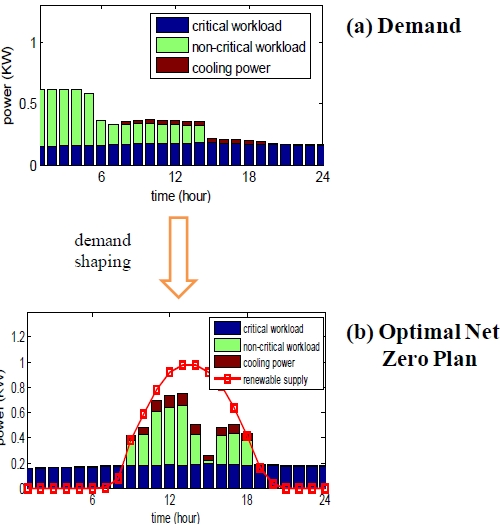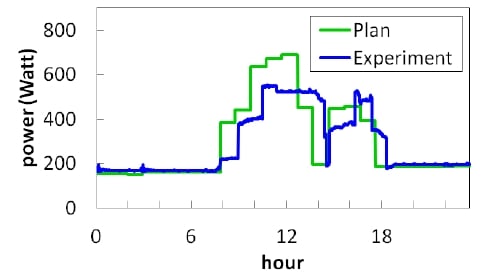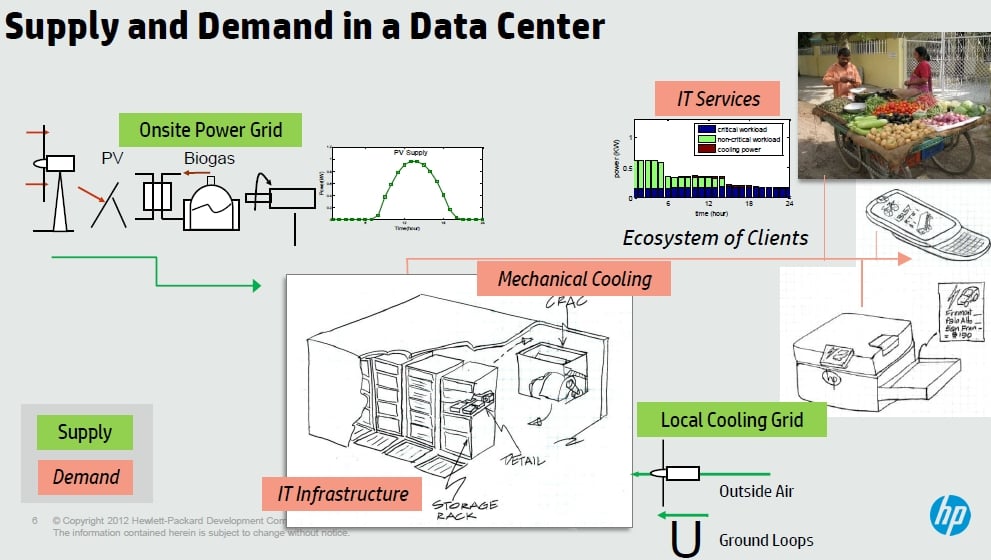This article is more than 1 year old
HP boffins create net-zero energy data center
Crunch while the sun shines
Farmers make hay when the sun shines, and maybe data centers should crunch data and do the bulk of their work then, too. That's what the techies at HP Labs, who have been marrying renewable energy and data centers together in a testbed, are beginning to think.
The HP boffins have managed to talk at least one of the recent CEOs of the company to allow them to build a baby data center at HQ that has room for lots of server, storage, and networking gear and that is powered by a photovoltaic array that can generate a peak of 134 kilowatts of juice when the sun is shining brightly in the middle of the day.
Once HP had a data center and the PV array, explains Cullen Bash, interim director of the Sustainable Ecosystem Research Group at HP Labs, then it was natural to try to get the data center to run, doing real work, within the power budget that the renewable energy source provided. And the idea behind the Net-Zero Energy Data Center is just that: crunch while the sun shines, the wind blows, and the water flows.
While this approach is certainly not appropriate for the vast majority of data centers operating today, given their loads, their locations, and the lack of solar, wind, hydro, or other renewable energy sources (such as gas turbines powered by waste). In many locations of the world where reliable energy sources are hard to come by, a net-zero energy data center might be the only practical way to provide any IT services at all.
This is especially the case when you consider that energy consumption for both juicing up the IT gear and cooling it down accounts for 70 per cent of data center costs, according to Bash. In essence, the cost of energy is the cost of an IT service.
And even if you can't get off grid, you can still use the approaches and the software that HP Labs has developed to match the running of IT jobs to available power to reduce your dependence on the local power grid – or better still, to times when power is less expensive to buy.
Bash and his colleagues at HP are presenting the results of their study in net-zero energy data centers at the IEEE's Intersociety Conference on Thermal and Thermomechanical Phenomena in Electronic Systems in San Diego, California this week and will be publishing their research paper later this month.
The goal that HP Labs set is to be able to construct and operate a data center that consumes a net zero amount of energy from the power grid over its lifetime and also has a two-year payback while also meeting service level agreements for real workloads.
The HP testbed data center for seeing how you might do this is located Palo Alto. This data center, which is used for lots of different experiments at HP, has 85 racks of IT equipment and eight computer room air condition (CRAC) units, which get cool water from mechanical chillers. The racks have temperature sensors to tell the CRACs when they are getting hot. The data center also has an outside-air economizer, which lets the data center suck in cooler air from outside the data center, filter it, and use it instead of the CRACs to cool gear.
HP has a grid of PV panels that powers the CRACs and chillers (its power output was not divulged) and another PV grid for powering up the IT gear that can deliver 134 kilowatts of power at peak. These PV grids are tied into the power grid so the data center doesn't shut down when the PV grid isn't working.
Relying solely on renewable energy is not the point of the net-zero energy experiment. Trying to get work done and run the CRACs during the day within the power generated by the PV array was the point. And of course, HP is cheating a bit by using the power grid to store excess electricity generated during the day, which it uses to run mission critical workloads that run 24x7 in the testbed data center.
Obviously, this is not practical in some of the potential areas where such a net-zero data center might be deployed, and some other means of storing power or generating it when renewable energy cannot give the juice has to be provided.
The costs of using the external electricity grid built and maintained by the power company and paying for the PV array are not detailed in the HP report, but obviously for any full analysis, these costs cannot be externalized. HP's net zero is only on an operational basis, not with fully burdened capital and operational costs. That PV grid alone might run you $500,000, El Reg estimates.
The three tenets of the net-zero energy data center prototype are, according to Bash, to avoid doing nothing, to do nothing well, and to keep the energy budget in balance, matching workloads with available juice. The idea is that you shift non-critical work (in this case, a mix of 24 batch jobs including laptop backups, scientific computing, animation and image processing, and financial analysis applications) to the times when you are generating lots of power so the mission-critical apps (for example an eBay-like online auction system) could keep running within the leftover power budget, partially directly from the PV grid and partially from energy stored in the external electricity grid.
There are four modules in the software stack that HP created for the net-zero energy data center experiment. The first is a prediction module, which predicts energy availability and workload demand based on data about the Palo Alto data center that HP collected before the experiment began. This prediction module was created in conjunction with Virginia Tech and the University of Limerick, by the way.
The planning module is where the operational goals of the data center and IT workload planning are matched up, including how much juice you want to pull from the grid and what kinds of service level agreements you want to set for particular workloads and their time of operation.
The execution module provisions the IT workloads as well as controls the cooling of the data center, and the verification and reporting module shows where the execution did or did not meet the plans set out by the planning module. Bash says that all of this software is implemented on Linux-based x86 servers, and that most of it is based on open source code, although he did not identify the programs.
In the test run that HP documented in its paper, the mixed workloads were run on four ProLiant BL465c blade servers, each with two 12-core Opteron 6100 processors and 64GB of main memory. The workloads were run on top of the KVM hypervisor.
All told, those four machines were allocated power from the PV grid that went from zero during dark hours to 1 kilowatt at peak in the middle of the day, and HP's software said that it could take the workloads, including the portion of the cooling in the data center required by those four servers, and shift the workloads around and stay within the power budget of the allocation it made from the PV grid. Here was the demand before the software was fired up and the plan after it ran for a 24-hour cycle:

And here is how the net-zero software actually ran against the plan:

As you can see, it is tough to get the plan and the real world in lockstep. But this is the real trick as far as HP is concerned, and it provides more savings than a flat plan that schedules non-critical workloads evenly across the day or a common plan of running non-critical jobs at night, which HP itself does in its data center.
It is not clear when or if this net-zero energy data center will be commercialized, but Bash says that HP is looking at rolling out the software in its Fort Collins, Colorado production data center and is also looking at marrying it with an EcoPod containerized data center facility running in Houston, Texas. ®


